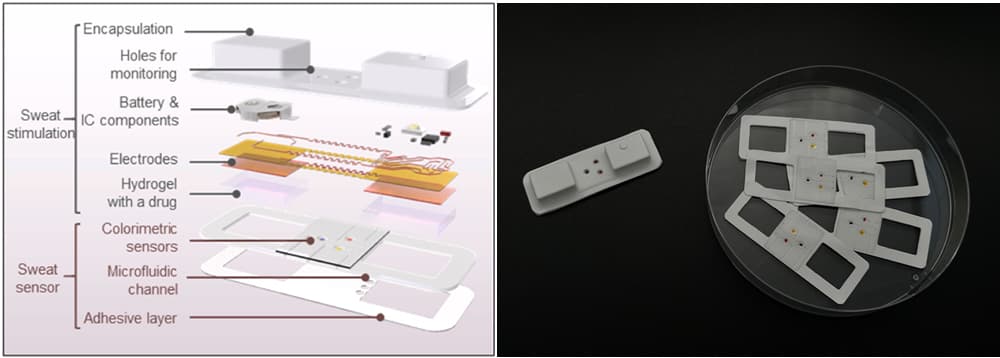If you don’t like getting needles or working out, this new medical wearable may be for you. It analyzes sweat instead of blood, and it doesn’t require patients to generate that sweat by performing strenuous exercises.
First of all, there are already multiple skin-adhered patches which detect biomarker chemicals in the wearer’s sweat. Concentrations of those chemicals in the sweat correlate to those in the bloodstream.
While these patches do provide a painless alternative to needle-drawn blood sampling, they require patients to work up a sweat by running on a treadmill or performing some other type of intense exercise. These activities typically must be performed in a clinic, plus not everyone can perform them – examples of such people include infants and individuals with limited mobility.
One alternative involves utilizing strap-on devices that stimulate the sweat glands to release sweat solely via the application of a mild electric current. These gadgets tend to be relatively large, complex and expensive, however, plus they must be applied and operated by trained personnel in a clinical setting.
The new wearable is claimed to combine the best aspects of both systems, without their drawbacks. It is being developed by scientists from the Korea Institute of Science and Technology (KIST) and Northwestern University in Illinois.

Korea Institute of Science and Technology
The self-contained device takes the form of a small flexible rectangular patch which is applied to the patient’s skin. It contains components such as a battery, two electrodes, an integrated circuit, microfluidic channels, and colorimetric sensors. On its adhesive underside are two sections of hydrogel containing a drug known as pilocarpine.
Upon being powered up, the patch’s electrodes deliver a weak electric current to the hydrogel. This triggers the pilocarpine in the gel to stimulate adjacent sweat glands in the skin, causing them to release sweat.
That sweat is carried through the microfluidic channels by capillary action, ending up in small reservoirs atop the colorimetric sensors. If specific biomarkers are present in that sweat, the sensors will change color. Peepholes in the patch allow patients to view the sensors themselves, after applying the patch in their own home and going about their regular activities.
In a test of the technology, a batch of the patches were applied to babies who had already been diagnosed with cystic fibrosis. The devices were found to detect elevated levels of chloride – a reliable indicator of the disease – with an accuracy of over 98%. That figure falls in line with the accuracy of a traditional hospital-based sweat-analysis system which was used on the same infants.
The patches also proved accurate at detecting telltale zinc and iron concentrations in the sweat, which are known biomarkers for cystic-fibrosis-related malnutrition.
“We have not only addressed the limitations of existing methods for inducing sweat but also achieved success in clinical research, bringing us one step closer to commercialization,” says Northwestern’s Prof. John A. Rogers, who led the study along with KIST’s Dr. Kim Joohee. “We plan to conduct large-scale clinical studies and commercialization, including adults, in the future.”
A paper on the research was recently published in the journal Biosensors and Bioelectronics.
Source: National Research Council of Science & Technology via EurekAlert
Source of Article